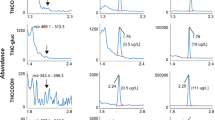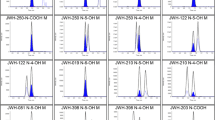Abstract
A sensitive and specific analytical method for cannabidiol (CBD) in urine was needed to define urinary CBD pharmacokinetics after controlled CBD administration, and to confirm compliance with CBD medications including Sativex—a cannabis plant extract containing 1:1 ∆9-tetrahydrocannabinol (THC) and CBD. Non-psychoactive CBD has a wide range of therapeutic applications and may also influence psychotropic smoked cannabis effects. Few methods exist for the quantification of CBD excretion in urine, and no data are available for phase II metabolism of CBD to CBD-glucuronide or CBD-sulfate. We optimized the hydrolysis of CBD-glucuronide and/or -sulfate, and developed and validated a GC-MS method for urinary CBD quantification. Solid-phase extraction isolated and concentrated analytes prior to GC-MS. Method validation included overnight hydrolysis (16 h) at 37 °C with 2,500 units β-glucuronidase from Red Abalone. Calibration curves were fit by linear least squares regression with 1/x 2 weighting with linear ranges (r 2 > 0.990) of 2.5–100 ng/mL for non-hydrolyzed CBD and 2.5–500 ng/mL for enzyme-hydrolyzed CBD. Bias was 88.7–105.3 %, imprecision 1.4–6.4 % CV and extraction efficiency 82.5–92.7 % (no hydrolysis) and 34.3–47.0 % (enzyme hydrolysis). Enzyme-hydrolyzed urine specimens exhibited more than a 250-fold CBD concentration increase compared to alkaline and non-hydrolyzed specimens. This method can be applied for urinary CBD quantification and further pharmacokinetics characterization following controlled CBD administration.


Similar content being viewed by others
References
Izzo AA, Borrelli F, Capasso R, Di Marzo V, Mechoulam R (2009) Non-psychotropic plant cannabinoids: new therapeutic opportunities from an ancient herb. Trends Pharmacol Sci 30:515–527
Bergamaschi MM, Queiroz RH, Chagas MH, de Oliveira DC, De Martinis BS, Kapczinski F, Quevedo J, Roesler R, Schroder N, Nardi AE, Martin-Santos R, Hallak JE, Zuardi AW, Crippa JA (2011) Cannabidiol reduces the anxiety induced by simulated public speaking in treatment-naive social phobia patients. Neuropsychopharmacology 36:1219–1226
Zuardi AW (2008) Cannabidiol: from an inactive cannabinoid to a drug with wide spectrum of action. Rev Bras Psiquiatr 30:271–280
Bergamaschi MM, Queiroz RH, Zuardi AW, Crippa JA (2011) Safety and side effects of cannabidiol, a Cannabis sativa constituent. Curr Drug Saf 6:237–249
Schubart CD, Sommer IE, van Gastel WA, Goetgebuer RL, Kahn RS, Boks MP (2011) Cannabis with high cannabidiol content is associated with fewer psychotic experiences. Schizophr Res 130:216–221
Morgan CJ, Curran HV (2008) Effects of cannabidiol on schizophrenia-like symptoms in people who use cannabis. Br J Psychiatry 192:306–307
Zuardi AW, Shirakawa I, Finkelfarb E, Karniol IG (1982) Action of cannabidiol on the anxiety and other effects produced by delta 9-THC in normal subjects. Psychopharmacol (Berl) 76:245–250
Di Forti M, Morgan C, Dazzan P, Pariante C, Mondelli V, Marques TR, Handley R, Luzi S, Russo M, Paparelli A, Butt A, Stilo SA, Wiffen B, Powell J, Murray RM (2009) High-potency cannabis and the risk of psychosis. Br J Psychiatry 195:488–491
Leweke FM, Schneider U, Radwan M, Schmidt E, Emrich HM (2000) Different effects of nabilone and cannabidiol on binocular depth inversion in Man. Pharmacol Biochem Behav 66:175–181
Karniol IG, Shirakawa I, Kasinski N, Pfeferman A, Carlini EA (1974) Cannabidiol interferes with the effects of delta 9-tetrahydrocannabinol in man. Eur J Pharmacol 28:172–177
Zuardi AW, Hallak JEC, Crippa JAS (2012) Interaction between cannabidiol (CBD) and Delta(9)-tetrahydrocannabinol (THC): influence of administration interval and dose ratio between the cannabinoids. Psychopharmacology 219:247–249
Karschner EL, Darwin WD, Goodwin RS, Wright S, Huestis MA (2011) Plasma cannabinoid pharmacokinetics following controlled oral delta9-tetrahydrocannabinol and oromucosal cannabis extract administration. Clin Chem 57:66–75
Karschner EL, Darwin WD, McMahon RP, Liu F, Wright S, Goodwin RS, Huestis MA (2011) Subjective and physiological effects after controlled Sativex and oral THC administration. Clin Pharmacol Ther 89:400–407
Mechoulam R, Hanus L (2002) Cannabidiol: an overview of some chemical and pharmacological aspects. Part I: chemical aspects. Chem Phys Lipids 121:35–43
Huestis MA (2005) Pharmacokinetics and metabolism of the plant cannabinoids, delta9-tetrahydrocannabinol, cannabidiol and cannabinol. Handb Exp Pharmacol 168:657–690
Jiang R, Yamaori S, Takeda S, Yamamoto I, Watanabe K (2011) Identification of cytochrome P450 enzymes responsible for metabolism of cannabidiol by human liver microsomes. Life Sci 89:165–170
Wall ME, Brine DR, Perez-Reyes M (1976) Metabolism of cannabinoids in man. In: Braude MC, Szara S (eds) The pharmacology of marihuana. Raven, New York, pp 93–113
Paton WD, Pertwee RG (1972) Effect of cannabis and certain of its constituents on pentobarbitone sleeping time and phenazone metabolism. Br J Pharmacol 44:250–261
Harvey DJ, Mechoulam R (1990) Metabolites of cannabidiol identified in human urine. Xenobiotica 20:303–320
Harvey DJ, Martin BR, Paton WD (1976) Identification of the glucuronides of cannabidiol and hydroxycannabidiols in mouse liver. Biochem Pharmacol 25:2217–2219
Mazur A, Lichti CF, Prather PL, Zielinska AK, Bratton SM, Gallus-Zawada A, Finel M, Miller GP, Radominska-Pandya A, Moran JH (2009) Characterization of human hepatic and extrahepatic UDP-glucuronosyltransferase enzymes involved in the metabolism of classic cannabinoids. Drug Metab Dispos 37:1496–1504
Kemp PM, Abukhalaf IK, Manno JE, Manno BR, Alford DD, Abusada GA (1995) Cannabinoids in humans. I. Analysis of delta 9-tetrahydrocannabinol and six metabolites in plasma and urine using GC-MS. J Anal Toxicol 19:285–291
Kemp PM, Abukhalaf IK, Manno JE, Manno BR, Alford DD, McWilliams ME, Nixon FE, Fitzgerald MJ, Reeves RR, Wood MJ (1995) Cannabinoids in humans. II. The influence of three methods of hydrolysis on the concentration of THC and two metabolites in urine. J Anal Toxicol 19:292–298
Abraham TT, Lowe RH, Pirnay SO, Darwin WD, Huestis MA (2007) Simultaneous GC-EI-MS determination of delta9-tetrahydrocannabinol, 11-hydroxy-delta9-tetrahydrocannabinol, and 11-nor-9-carboxy-delta9-tetrahydrocannabinol in human urine following tandem enzyme-alkaline hydrolysis. J Anal Toxicol 31:477–485
Grauwiler SB, Scholer A, Drewe J (2007) Development of a LC/MS/MS method for the analysis of cannabinoids in human EDTA-plasma and urine after small doses of Cannabis sativa extracts. J Chromatogr B Analyt Technol Biomed Life Sci 850:515–522
Scheidweiler KB, Desrosiers NA, Huestis MA (2012) Simultaneous quantification of free and glucuronidated cannabinoids in human urine by liquid chromatography tandem mass spectrometry. Clin Chim Acta 413:1839–1847
GOMA Biotec (2011) GOMA Biotec Product Information Sheet - b-Glucuronidase from Haliotis rufescens (abalone). Product Information:1–2
Sigma-Aldrich (2005) Sigma Product Information Sheet—b-Glucuronidase Type IX-A from Escherichia coli. Product Information:1–2
Sigma-Aldrich (2008) Sigma Product Information Sheet—b-Glucuronidase Type HP-2 from Helix pomatia. Product Information:1–2
Zanchetti G, Floris I, Piccinotti A, Tameni S, Polettini A (2012) Rapid and robust confirmation and quantification of 11-nor-Delta9-tetrahydrocannabinol-9-carboxylic acid (THC-COOH) in urine by column switching LC-MS-MS analysis. J Mass Spectrom 47:124–130
Fernandez Mdel M, Wille SM, Samyn N, Wood M, Lopez-Rivadulla M, De Boeck G (2009) On-line solid-phase extraction combined with liquid chromatography-tandem mass spectrometry for high throughput analysis of 11-nor-Delta9-tetrahydrocannabinol-9-carboxylic acid in urine. J Chromatogr B Analyt Technol Biomed Life Sci 877:2153–2157
Paul BD, Mell LD Jr, Mitchell JM, McKinley RM, Irving J (1987) Detection and quantitation of urinary 11-nor-delta-9-tetrahydrocannabinol-9-carboxylic acid, a metabolite of tetrahydrocannabinol by capillary gas chromatography and electron impact mass fragmentography. J Anal Toxicol 11:1–5
Robandt PV, Klette KL, Sibum M (2009) Automated solid-phase extraction-liquid chromatography-tandem mass spectrometry analysis of 11-nor-Delta9-tetrahydrocannabinol-9-carboxylic acid in human urine specimens: application to a high-throughput urine analysis laboratory. J Anal Toxicol 33:456–460
Thomas BF, Compton DR, Martin BR (1990) Characterization of the lipophilicity of natural and synthetic analogs of delta 9-tetrahydrocannabinol and its relationship to pharmacological potency. J Pharmacol Exp Ther 255:624–630
Garrett ER, Hunt CA (1974) Physiochemical properties, solubility, and protein binding of delta-9-tetrahydrocannabinol. J Pharm Sci 63:1056–1064
Johnson JR, Jennison TA, Peat MA, Foltz RL (1984) Stability of delta-9-tetrahydrocannabinol (THC), 11-hydroxy-THC, and 11-nor-9-carboxy-THC in blood and plasma. J Anal Toxicol 8:202–204
Fairbairn JW, Liebmann JA, Rowan MG (1976) The stability of cannabis and its preparations on storage. J Pharm Pharmacol 28:1–7
Agurell S, Leander K (1971) Stability, transfer and absorption of cannabinoid constituents of cannabis (hashish) during smoking. Acta Pharmaceutica Suecica 8:391–402
Gray T, Barnes A, Huestis M (2010) Effect of hydrolysis on identifying prenatal cannabis exposure. Anal Bioanal Chem 397:2335–2347
Harvey DJ, Samara E, Mechoulam R (1991) Comparative metabolism of cannabidiol in dog, rat and man. Pharmacol Biochem Behav 40:523–532
Harvey DJ, Samara E, Mechoulam R (1991) Urinary metabolites of cannabidiol in dog, rat and man and their identification by gas chromatography–mass spectrometry. J Chromatogr 562:299–322
Karschner EL, Barnes AJ, Lowe RH, Scheidweiler KB, Huestis MA (2010) Validation of a two-dimensional gas chromatography mass spectrometry method for the simultaneous quantification of cannabidiol, Delta(9)-tetrahydrocannabinol (THC), 11-hydroxy-THC, and 11-nor-9-carboxy-THC in plasma. Anal Bioanal Chem 397:603–611
Gaoni Y, Mechoulam R (1966) Hashish VII: the isomerization of cannabidiol to tetrahydrocannabinols. Tetrahedron 22:1481–1488
Adams R, Pease DC, Cain CK, Clark JH (1940) Structure of cannabidiol. VI. Isornerization of cannabidiol to tetrahydrocannabinol, a physiologically active product. Conversion of cannabidiol to cannabinol. J Am Chem Soc 62:2402–2405
Acknowledgments
The authors acknowledge Jeff Hackett from United Chemical Technologies for his technical support and Georgia Yiannoulos for her assistance with the research subjects. Intramural Research Program, National Institute on Drug Abuse, NIH, funded this research as well as a grant DA027781 to YLH and UL1RR029887. MMB received grant from Coordenação de Aperfeiçoamento de Pessoal de Nível Superior (CAPES, Brazil).
Author information
Authors and Affiliations
Corresponding author
Rights and permissions
About this article
Cite this article
Bergamaschi, M.M., Barnes, A., Queiroz, R.H.C. et al. Impact of enzymatic and alkaline hydrolysis on CBD concentration in urine. Anal Bioanal Chem 405, 4679–4689 (2013). https://doi.org/10.1007/s00216-013-6837-x
Received:
Revised:
Accepted:
Published:
Issue Date:
DOI: https://doi.org/10.1007/s00216-013-6837-x




